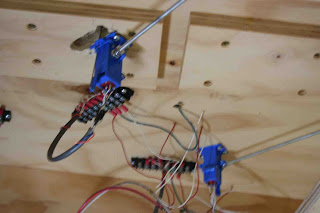Several items on my “To Do” check list prior to WOOPS involved switch throws at Oakridge. Three switches were highlighted by my crew over the past several months (operating sessions). I held off addressing them as they required moving a fair bit of under-the-layout storage out of the way for access. Preparing for WOOPS demanded these be addressed.
One switch proved very easy to fix. The switch throw rod had disconnected from the Blue Point switch machine. I use threaded rods for throw rods, with most initially just threaded into an appropriately sized screw eye attached to the Blue Point switch machine throw. Unfortunately, operators often twist the knob on the end of the throw rod, which can unscrew them from the switch machine. Such was the case with the first switch problem I addressed. It was a simple fix, although I added another nut to the connection at the switch machine which has helped make the connection more robust.
The second switch machine issue involved one of the cross-over switches used to emplace helpers mid-train in the Oakridge Yard. This switch was controlled by a Tortoise ™ by Circuitron switch machine. The points were not throwing all the way in the cross-over position. I had run out of the limited amount of fulcrum position adjustment on this machine, so I needed to replace the throw rod from the machine to the switch throw bar on my way to potentially adjusting the new throw rod. I got lucky. Simply replacing the prior throw rod which had a bend in it with a new straight throw rod cured the problem. Whew! Two down.
Oakridge cross-over switch not throwing all the way.
Replacement throw rod on the switch machine cured the switch throw issue for this Oakridge cross-over.
The final switch throw problem proved far more complex. The affected switch was in the Oakridge wye, branching to one of the maintenance of way spurs within the wye. Once again, the switch was not throwing all the way. This switch used a Blue Point switch machine. Once again, I exhausted the fulcrum adjustment capability, so a new throw rod was in order. Enter the infamous constant of the universe known as “Murphy’s Law” (with apologies to one of my regular crew members). If it could go wrong, it would—and did with multiple failures.
Access to the switch machine was in a difficult position. I needed to clear out a considerable amount of under-layout storage to gain decent access. That accomplished, I needed to both dismount the Blue Point switch machine and replace its throw rod. Somehow while cutting through the old throw rod, I must have clipped several of the wire leads to the Blue Point double post-double throw (DPDT) switch in the Blue Point. I needed to repair that wiring harness.
Blue Point switch machine with wiring harness repaired. The black shrink-wrap on the wires covers the spliced wire leads. Note that the throw rod is fixed to the throw mechanism with a bend just above the repaired wires at the base (left side) of the machine. This is what had to be cut to release the old throw rod.
The next problem that developed involved the switch throw bar. The reason this switch was not throwing all the way was that I apparently never really got the throw rod from the switch machine into a proper hole in the middle of the throw bar just under the points. I decided to move the throw rod connection to one of the holes outside the stock rails, as the middle of the throw bar did not look like it could support a new hole. That “support a new hole” proved correct, as just working with the throw bar ended up causing it to break. I have had several other throw bars on my Micro Engineering switches fail. The solution is to replace the throw bar with a pc board throw bar just like all of my Fast Tracks switches.
New pc board throw bar installed with the throw rod connection outside the stock rails. The drilling template in the foreground provides for proper mounting screw geometry for the Blue Point switch machine underneath.
I carried through with my decision to mount the throw rod connection outside the stock rails, so a new mounting for the Blue Point would be needed. That led to yet another problem. As noted in the photo above, I used a drill template to fix the mounting screw holes. When I mounted the Blue Point switch machine in its new location, it turned out a simple straight throw rod would do, with no side-to-side bends. I thought everything was going fine, so I trimmed the throw rod on top of the layout, hooked up the big threaded throw rod to the layout fascia and tested. The switch STILL did not throw all the way!
Blue Point switch machines mounted under the layout. The closer one (top) was the problem machine. Close inspection of this photo shows the throw rod is rubbing against the uneven edge of the slot cut into the plywood sub-roadbed.
I let the problem sit overnight so I had a clear mind when I next looked at the problem. With that, I could see the uneven slot routed into the plywood sub-roadbed was impeding the throw rod coming up from the switch machine. A bit of router work cured the problem. Sometimes waiting a bit to clear the mind helps find the real source of a problem.
Three switch throw issues that lingered for several months have now been corrected. Oakridge should operate much better now!

















